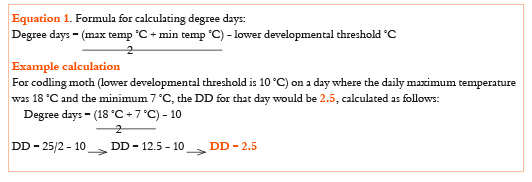What are degree days?
What are degree days?
Insect development is temperature-driven.
Degree days (DD) are a measure of temperature over time and it is used to predict the timing of life stages of certain insect pests.
A degree day model counts the total time that temperature is above the minimum required for the pest to develop (lower developmental threshold).
Models
There are established DD models for codling moth (CM), light brown apple moth (LBAM) and oriental fruit moth (OFM).
These are best at predicting the first generation of activity and typically become less reliable with subsequent generations as the season progresses.
For this reason, some insecticide labels for these key pests include DD recommendations for the timing of the first sprays.
Knowing how to calculate DD will help to time the first sprays effectively.
What do you need?
To use DD for your first spray timing, you’ll need:
• pheromone traps to determine biofix
• thermometer (max-min or weather station)
• calculator or spreadsheet
What is biofix?
Biofix is the date of the first sustained flight of adult moths recorded in pheromone traps.
It is used as a starting point for the accumulation of degree days and to guide the timing of the first spray.
How to determine the biofix
Deploy traps at a density of about one per hectare, ensuring coverage of the warmest part of the orchard and any known hotspots where damage occurred in the previous season(s).
Establish traps at least one week before bloom for codling moth and OFM, but bud break for LBAM.
The aim is to record at least 2 weeks with no moths in the traps before the first flights begin. This will increase your confidence in determining the biofix when moths do emerge from their overwintering pupation sites and fly into the canopy.
Checking traps daily until the first sustained moth flight is recorded will increase the accuracy of the biofix date that you set.
Calculating & accumulating DD from biofix
A simple formula for calculating DD using daily maximum and minimum temperatures and the lower developmental threshold for your pest is shown in Equation 1.
The lower developmental threshold for CM is 10C, LBAM is 7C and OFM is 7.5C
DDs are calculated daily from biofix and added together to give Cumulative Degree Days (CDD).
If using a max-min thermometer, this is best housed in a Stevenson screen (see above) to ensure accurate measurement of ambient temperature, which can be recorded in a spreadsheet or on paper.
Some weather stations with inbuilt models will track DD accumulation and predict first spray timing.
Label recommendations for spray timing
Most insecticides for CM, OFM and LBAM target the start of egg hatch (i.e. larval stages). The active ingredient fenoxycarb is a notable exception that only controls newly laid eggs.
Codling moth and Oriental fruit moth egg hatch occurs on average at approximately 110 CDD from biofix, while LBAM egg hatch occurs around 140 CDD.
Refer to product labels for recommendations on timing applications based on cumulative degree days.

Download the Orchard plant protection guide
See this article in Tree Fruit October 2023




















